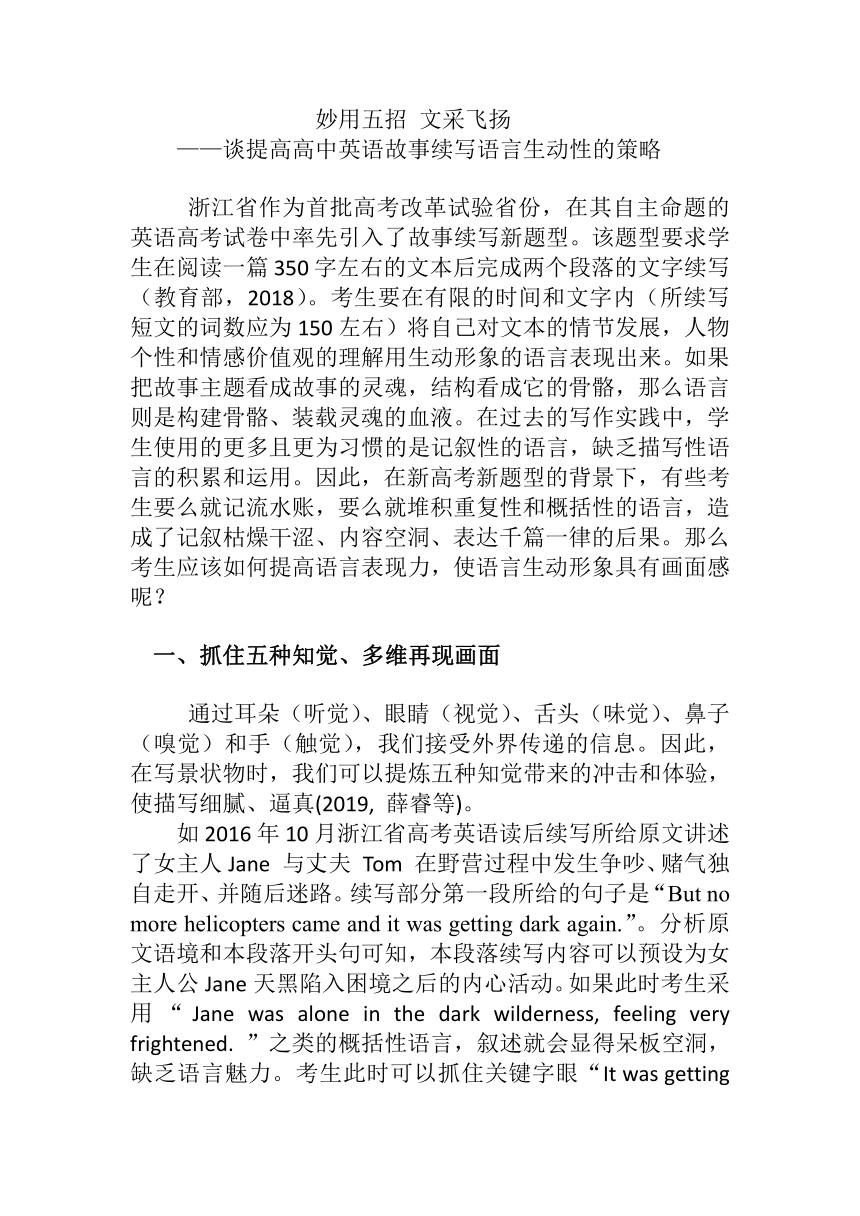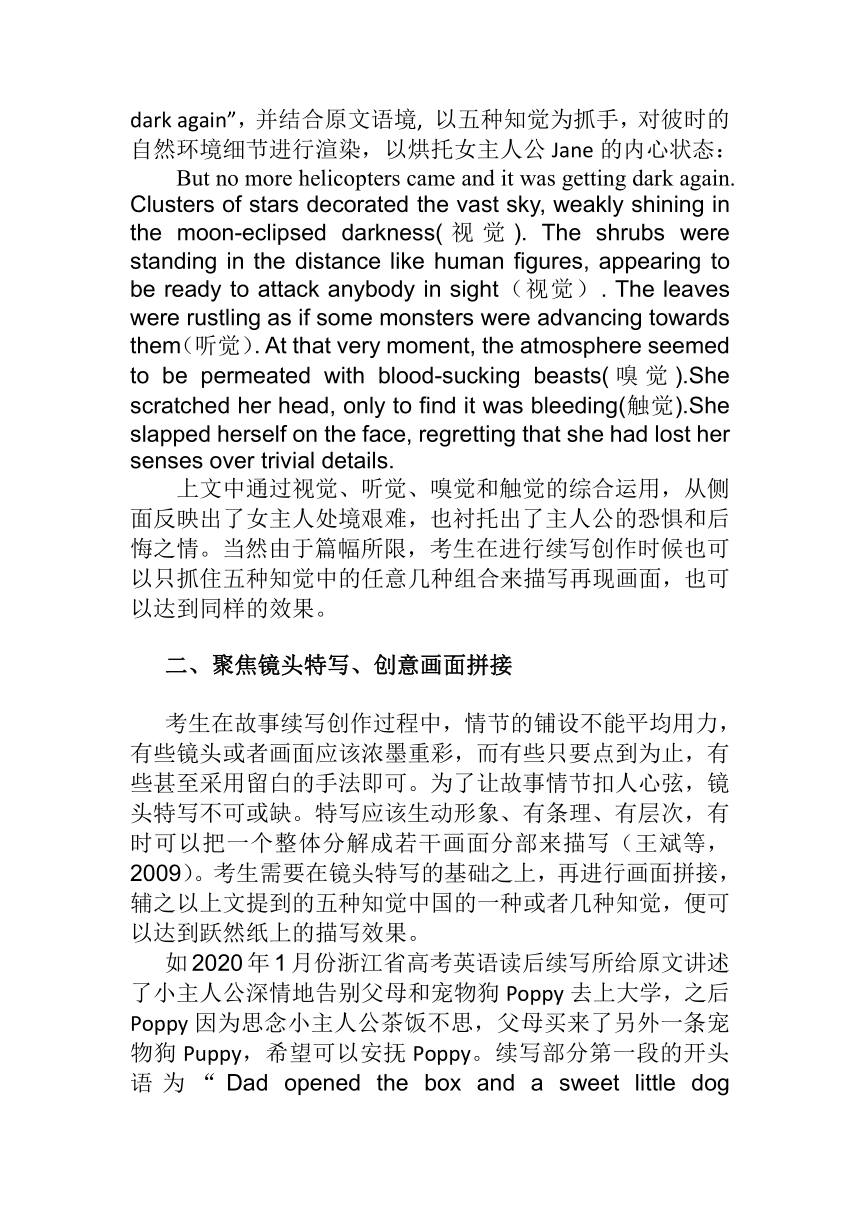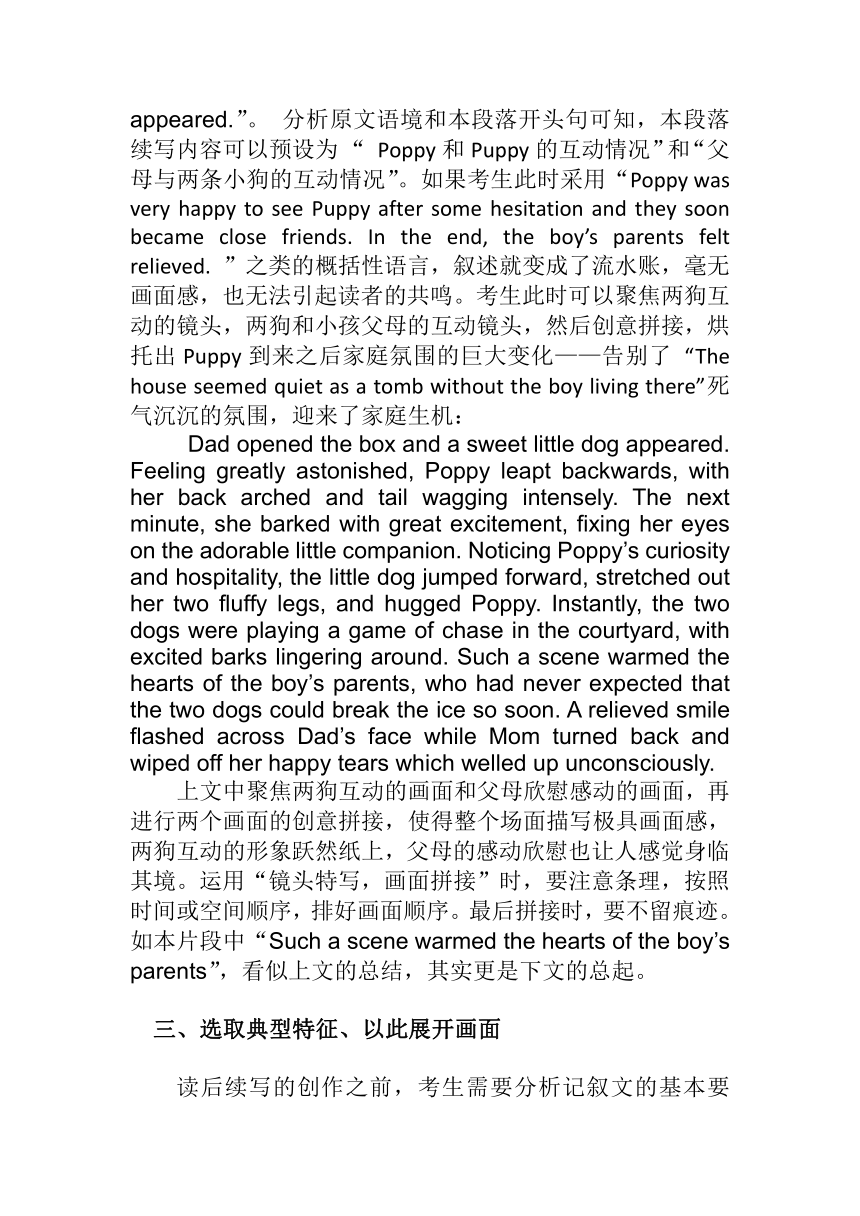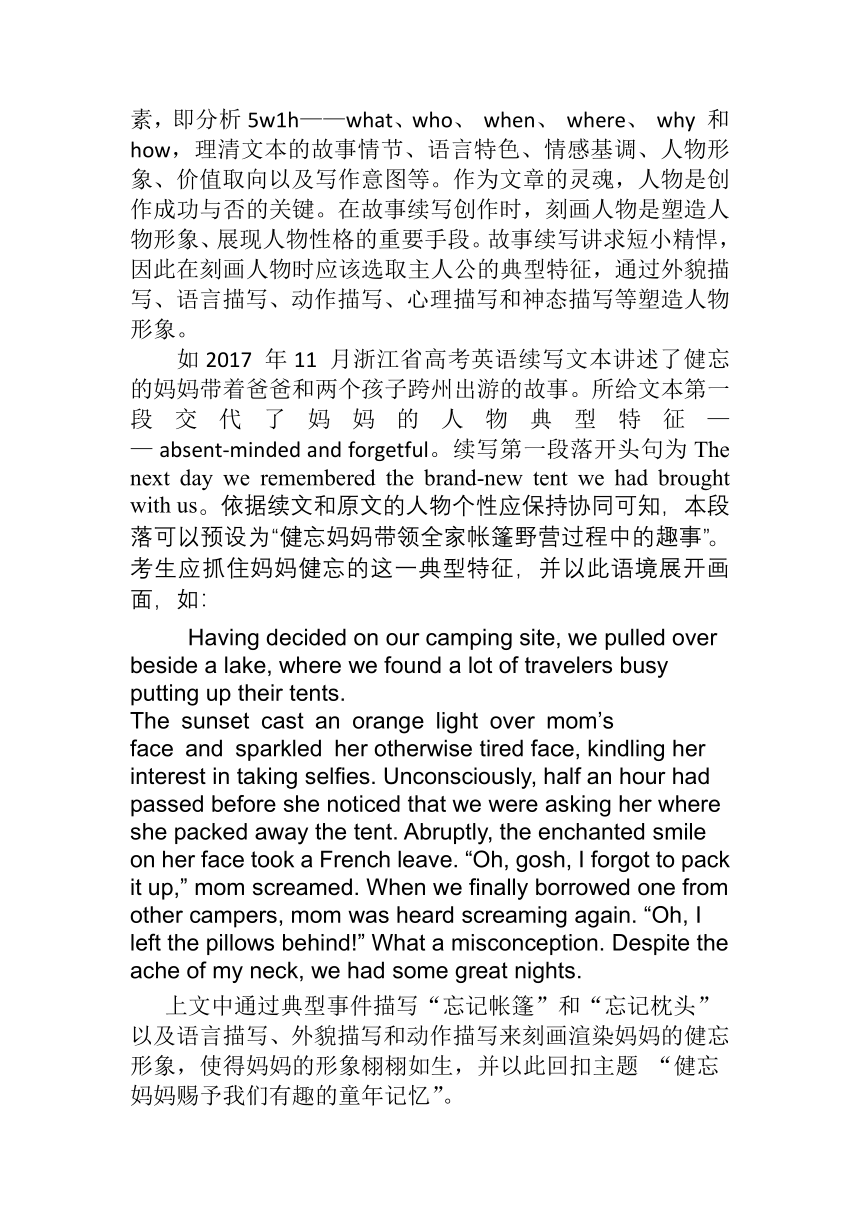2022届高考英语二轮复习:读后续写语言精进策略 学案
文档属性
| 名称 | 2022届高考英语二轮复习:读后续写语言精进策略 学案 |  | |
| 格式 | doc | ||
| 文件大小 | 72.5KB | ||
| 资源类型 | 教案 | ||
| 版本资源 | 通用版 | ||
| 科目 | 英语 | ||
| 更新时间 | 2021-12-27 17:48:50 | ||
图片预览




文档简介
妙用五招 文采飞扬
——谈提高高中英语故事续写语言生动性的策略
浙江省作为首批高考改革试验省份,在其自主命题的英语高考试卷中率先引入了故事续写新题型。该题型要求学生在阅读一篇350字左右的文本后完成两个段落的文字续写(教育部,2018)。考生要在有限的时间和文字内(所续写短文的词数应为150左右)将自己对文本的情节发展,人物个性和情感价值观的理解用生动形象的语言表现出来。如果把故事主题看成故事的灵魂,结构看成它的骨骼,那么语言则是构建骨骼、装载灵魂的血液。在过去的写作实践中,学生使用的更多且更为习惯的是记叙性的语言,缺乏描写性语言的积累和运用。因此,在新高考新题型的背景下,有些考生要么就记流水账,要么就堆积重复性和概括性的语言,造成了记叙枯燥干涩、内容空洞、表达千篇一律的后果。那么考生应该如何提高语言表现力,使语言生动形象具有画面感呢?
一、抓住五种知觉、多维再现画面
通过耳朵(听觉)、眼睛(视觉)、舌头(味觉)、鼻子(嗅觉)和手(触觉),我们接受外界传递的信息。因此,在写景状物时,我们可以提炼五种知觉带来的冲击和体验,使描写细腻、逼真(2019, 薛睿等)。
如2016年10月浙江省高考英语读后续写所给原文讲述了女主人Jane 与丈夫 Tom 在野营过程中发生争吵、赌气独自走开、并随后迷路。续写部分第一段所给的句子是“But no more helicopters came and it was getting dark again.”。分析原文语境和本段落开头句可知,本段落续写内容可以预设为女主人公Jane天黑陷入困境之后的内心活动。如果此时考生采用“Jane was alone in the dark wilderness, feeling very frightened. ”之类的概括性语言,叙述就会显得呆板空洞,缺乏语言魅力。考生此时可以抓住关键字眼“It was getting dark again”,并结合原文语境, 以五种知觉为抓手,对彼时的自然环境细节进行渲染,以烘托女主人公Jane的内心状态:
But no more helicopters came and it was getting dark again. Clusters of stars decorated the vast sky, weakly shining in the moon-eclipsed darkness(视觉). The shrubs were standing in the distance like human figures, appearing to be ready to attack anybody in sight(视觉). The leaves were rustling as if some monsters were advancing towards them(听觉). At that very moment, the atmosphere seemed to be permeated with blood-sucking beasts(嗅觉).She scratched her head, only to find it was bleeding(触觉).She slapped herself on the face, regretting that she had lost her senses over trivial details.
上文中通过视觉、听觉、嗅觉和触觉的综合运用,从侧面反映出了女主人处境艰难,也衬托出了主人公的恐惧和后悔之情。当然由于篇幅所限,考生在进行续写创作时候也可以只抓住五种知觉中的任意几种组合来描写再现画面,也可以达到同样的效果。
二、聚焦镜头特写、创意画面拼接
考生在故事续写创作过程中,情节的铺设不能平均用力,有些镜头或者画面应该浓墨重彩,而有些只要点到为止,有些甚至采用留白的手法即可。为了让故事情节扣人心弦,镜头特写不可或缺。特写应该生动形象、有条理、有层次,有时可以把一个整体分解成若干画面分部来描写(王斌等,2009)。考生需要在镜头特写的基础之上,再进行画面拼接,辅之以上文提到的五种知觉中国的一种或者几种知觉,便可以达到跃然纸上的描写效果。
如2020年1月份浙江省高考英语读后续写所给原文讲述了小主人公深情地告别父母和宠物狗Poppy去上大学,之后Poppy因为思念小主人公茶饭不思,父母买来了另外一条宠物狗Puppy,希望可以安抚Poppy。续写部分第一段的开头语为“Dad opened the box and a sweet little dog appeared.”。 分析原文语境和本段落开头句可知,本段落续写内容可以预设为 “ Poppy和Puppy的互动情况”和“父母与两条小狗的互动情况”。如果考生此时采用“Poppy was very happy to see Puppy after some hesitation and they soon became close friends. In the end, the boy’s parents felt relieved. ”之类的概括性语言,叙述就变成了流水账,毫无画面感,也无法引起读者的共鸣。考生此时可以聚焦两狗互动的镜头,两狗和小孩父母的互动镜头,然后创意拼接,烘托出Puppy到来之后家庭氛围的巨大变化——告别了 “The house seemed quiet as a tomb without the boy living there”死气沉沉的氛围,迎来了家庭生机:
Dad opened the box and a sweet little dog appeared. Feeling greatly astonished, Poppy leapt backwards, with her back arched and tail wagging intensely. The next minute, she barked with great excitement, fixing her eyes on the adorable little companion. Noticing Poppy’s curiosity and hospitality, the little dog jumped forward, stretched out her two fluffy legs, and hugged Poppy. Instantly, the two dogs were playing a game of chase in the courtyard, with excited barks lingering around. Such a scene warmed the hearts of the boy’s parents, who had never expected that the two dogs could break the ice so soon. A relieved smile flashed across Dad’s face while Mom turned back and wiped off her happy tears which welled up unconsciously.
上文中聚焦两狗互动的画面和父母欣慰感动的画面,再进行两个画面的创意拼接,使得整个场面描写极具画面感,两狗互动的形象跃然纸上,父母的感动欣慰也让人感觉身临其境。运用“镜头特写,画面拼接”时,要注意条理,按照时间或空间顺序,排好画面顺序。最后拼接时,要不留痕迹。 如本片段中“Such a scene warmed the hearts of the boy’s parents”,看似上文的总结,其实更是下文的总起。
三、选取典型特征、以此展开画面
读后续写的创作之前,考生需要分析记叙文的基本要素,即分析5w1h——what、who、 when、 where、 why 和how,理清文本的故事情节、语言特色、情感基调、人物形象、价值取向以及写作意图等。作为文章的灵魂,人物是创作成功与否的关键。在故事续写创作时,刻画人物是塑造人物形象、展现人物性格的重要手段。故事续写讲求短小精悍,因此在刻画人物时应该选取主人公的典型特征,通过外貌描写、语言描写、动作描写、心理描写和神态描写等塑造人物形象。
如2017 年11 月浙江省高考英语续写文本讲述了健忘的妈妈带着爸爸和两个孩子跨州出游的故事。所给文本第一段交代了妈妈的人物典型特征—— absent-minded and forgetful。续写第一段落开头句为 The next day we remembered the brand-new tent we had brought with us。依据续文和原文的人物个性应保持协同可知,本段落可以预设为“健忘妈妈带领全家帐篷野营过程中的趣事”。考生应抓住妈妈健忘的这一典型特征,并以此语境展开画面,如:
Having decided on our camping site, we pulled over beside a lake, where we found a lot of travelers busy putting up their tents. The sunset cast an orange light over mom’s face and sparkled her otherwise tired face, kindling her interest in taking selfies. Unconsciously, half an hour had passed before she noticed that we were asking her where she packed away the tent. Abruptly, the enchanted smile on her face took a French leave. “Oh, gosh, I forgot to pack it up,” mom screamed. When we finally borrowed one from other campers, mom was heard screaming again. “Oh, I left the pillows behind!” What a misconception. Despite the ache of my neck, we had some great nights.
上文中通过典型事件描写“忘记帐篷”和“忘记枕头”以及语言描写、外貌描写和动作描写来刻画渲染妈妈的健忘形象,使得妈妈的形象栩栩如生,并以此回扣主题 “健忘妈妈赐予我们有趣的童年记忆”。
善用修辞、激活画面
故事续写在叙事抒情时可以借助一些修辞手法来取得理想的表达效果。英语中的修辞繁多,笔者仅举适宜于故事续写的其中几例。 例如,比喻(simile and metaphor)能生动形象、简洁凝练地描写事物,化抽象为具体;拟人(personification)可以赋予事物以人的思想、感情、个性和动作,使物人格化,从而达到生动形象之效果;夸张(hyperbole)能凸显人或物的特征,从而给读者强烈而鲜明的印象;拟声词(onomatopoeia)的运用能形象生动地再现人物心情、事物特征,动作行为状态,使读者产生联想。押韵(alliteration and rhyme) 则能赋予读者诗歌一般的美感与享受。
如2017年6月浙江省高考英语续写文本讲述了Mac因为脱离同伴独自骑行,路遇野狼袭击的故事。续文第一段的开头语为 “The car abruptly stopped in front of him.”。分析原文可知,续写第一段续写内容可以设定为“司机搭救、奋勇逃生”的惊险画面。为了使画面更具冲击力,可以尝试使用多种修辞,如:
The car abruptly stopped in front of him. A man screeched(拟声) the car to a sudden stop, and stretched out his hand, bellowing, “Get in!” Mac clutched at the last straw(比喻) without delay of even one second, flung his bicycle behind , flew into(夸张) the car and banged the door closed behind him. The blood in his body was boiling(夸张) and his hairs were standing up, making him gasp. Sitting still in shock, he was trembling all over, fearing as if the fiery eyes of the bloodthirsty wolf would penetrate the steel window of the car(夸张). A chill crept down his spine(拟人), spawning goose bumps .However, the car whizzed away(拟声), leaving the wolf far behind, which made him sigh(拟声) with relief. Mac thanked Paul and Becky and afterwards they pulled over by the road to wait for Mac’s friends.
通过一系列修辞的合理运用,作者把司机搭救、奋勇逃生、劫后惊魂未定的场面描写塑造得惊心动魄,亦让读者身临其境,血脉喷张。
运用文字技巧、活化语言运用
在进行故事写续实践时,考生还可以灵活运用文字技巧,使语言生动形象化,场景描写可视化。语言技巧的习得关键在于训练与积累,可以从句子训练做起,然后拓展到片段描写,最后过渡语篇层面。
用“实义动词+修辞”替换be动词(S. P. Bakshi, 2014)。如:
(1) It was a rainy day. (用be 动词表达)
(2)The rain fell pitter patter on the window made of canvas.(用“实义动词fall pitter patter+拟声”替换be动词)
(3)Raindrops also dripped down from the eaves as if they would never want to have a rest.(用 “实义动词drip+拟人”替换be 动词)
(4)The rain wove a thick silk cascade, blurring my sight.(用实义动词“实义动词weave+比喻”替换be)
(5)The rain drummed on the window, putting on an orchestra together the twitter of the birds and chirp of the insects. (用“实义动词drum+比喻”替换be 动词)
对比句子(1)与句子(2)、(3)、(4)、(5)可以感觉到,be动词的表达不如“实义动词+修辞”那么形象生动,也无法创设具有画面感的语境之美。
用表意更具体的实义动词替换表意相对笼统的实义动词。如:
(1) “I have something to tell you,” the boss said. (用实义动词say来表达“说”,听者不明其意。)
(2) “I have something to tell you,” the boss boasted. (用实义动词boast来表达“说”,听者知道老板要炫耀一番。)
(3) “I have something to tell you,” the boss whined. (用实义动词whine来表达“说”,听者知道老板要哭诉一番。)
(4) “I have something to tell you,” the boss announced. (用实义动词announced来表达“说”,听者知道老板要宣布事项。)
(5) “I have something to tell you,” the boss whispered. (用实义动词whisper来表达“说”,听者知道老板有秘密要分享。)
对比句子(1)与句子(2)、(3)、(4)、(5)可知,有时表意相对笼统的实义动词枯燥死板,有时甚至会让听者不明其意。而更具体的实义动词达意,且生动形象,令人眼前浮现画面。当然,文字运用技巧还有很多,希望本文能起抛砖引玉的作用。
总之,一篇优秀的故事续写文章,所续写段落要与原文内容、语言、结构和情节等方面高度协同的基础上,续写部分语言要做到丰富、形象生动和具有画面感。因此,学生在进行故事续写创作时,应立足文本语境,挖掘故事主题,展开故事情节,尝试利用上述五种策略描绘形象,唤起语言表象的艺术功能,使写作生动形象具有画面感,以此塑造细节,强化主题。
——谈提高高中英语故事续写语言生动性的策略
浙江省作为首批高考改革试验省份,在其自主命题的英语高考试卷中率先引入了故事续写新题型。该题型要求学生在阅读一篇350字左右的文本后完成两个段落的文字续写(教育部,2018)。考生要在有限的时间和文字内(所续写短文的词数应为150左右)将自己对文本的情节发展,人物个性和情感价值观的理解用生动形象的语言表现出来。如果把故事主题看成故事的灵魂,结构看成它的骨骼,那么语言则是构建骨骼、装载灵魂的血液。在过去的写作实践中,学生使用的更多且更为习惯的是记叙性的语言,缺乏描写性语言的积累和运用。因此,在新高考新题型的背景下,有些考生要么就记流水账,要么就堆积重复性和概括性的语言,造成了记叙枯燥干涩、内容空洞、表达千篇一律的后果。那么考生应该如何提高语言表现力,使语言生动形象具有画面感呢?
一、抓住五种知觉、多维再现画面
通过耳朵(听觉)、眼睛(视觉)、舌头(味觉)、鼻子(嗅觉)和手(触觉),我们接受外界传递的信息。因此,在写景状物时,我们可以提炼五种知觉带来的冲击和体验,使描写细腻、逼真(2019, 薛睿等)。
如2016年10月浙江省高考英语读后续写所给原文讲述了女主人Jane 与丈夫 Tom 在野营过程中发生争吵、赌气独自走开、并随后迷路。续写部分第一段所给的句子是“But no more helicopters came and it was getting dark again.”。分析原文语境和本段落开头句可知,本段落续写内容可以预设为女主人公Jane天黑陷入困境之后的内心活动。如果此时考生采用“Jane was alone in the dark wilderness, feeling very frightened. ”之类的概括性语言,叙述就会显得呆板空洞,缺乏语言魅力。考生此时可以抓住关键字眼“It was getting dark again”,并结合原文语境, 以五种知觉为抓手,对彼时的自然环境细节进行渲染,以烘托女主人公Jane的内心状态:
But no more helicopters came and it was getting dark again. Clusters of stars decorated the vast sky, weakly shining in the moon-eclipsed darkness(视觉). The shrubs were standing in the distance like human figures, appearing to be ready to attack anybody in sight(视觉). The leaves were rustling as if some monsters were advancing towards them(听觉). At that very moment, the atmosphere seemed to be permeated with blood-sucking beasts(嗅觉).She scratched her head, only to find it was bleeding(触觉).She slapped herself on the face, regretting that she had lost her senses over trivial details.
上文中通过视觉、听觉、嗅觉和触觉的综合运用,从侧面反映出了女主人处境艰难,也衬托出了主人公的恐惧和后悔之情。当然由于篇幅所限,考生在进行续写创作时候也可以只抓住五种知觉中的任意几种组合来描写再现画面,也可以达到同样的效果。
二、聚焦镜头特写、创意画面拼接
考生在故事续写创作过程中,情节的铺设不能平均用力,有些镜头或者画面应该浓墨重彩,而有些只要点到为止,有些甚至采用留白的手法即可。为了让故事情节扣人心弦,镜头特写不可或缺。特写应该生动形象、有条理、有层次,有时可以把一个整体分解成若干画面分部来描写(王斌等,2009)。考生需要在镜头特写的基础之上,再进行画面拼接,辅之以上文提到的五种知觉中国的一种或者几种知觉,便可以达到跃然纸上的描写效果。
如2020年1月份浙江省高考英语读后续写所给原文讲述了小主人公深情地告别父母和宠物狗Poppy去上大学,之后Poppy因为思念小主人公茶饭不思,父母买来了另外一条宠物狗Puppy,希望可以安抚Poppy。续写部分第一段的开头语为“Dad opened the box and a sweet little dog appeared.”。 分析原文语境和本段落开头句可知,本段落续写内容可以预设为 “ Poppy和Puppy的互动情况”和“父母与两条小狗的互动情况”。如果考生此时采用“Poppy was very happy to see Puppy after some hesitation and they soon became close friends. In the end, the boy’s parents felt relieved. ”之类的概括性语言,叙述就变成了流水账,毫无画面感,也无法引起读者的共鸣。考生此时可以聚焦两狗互动的镜头,两狗和小孩父母的互动镜头,然后创意拼接,烘托出Puppy到来之后家庭氛围的巨大变化——告别了 “The house seemed quiet as a tomb without the boy living there”死气沉沉的氛围,迎来了家庭生机:
Dad opened the box and a sweet little dog appeared. Feeling greatly astonished, Poppy leapt backwards, with her back arched and tail wagging intensely. The next minute, she barked with great excitement, fixing her eyes on the adorable little companion. Noticing Poppy’s curiosity and hospitality, the little dog jumped forward, stretched out her two fluffy legs, and hugged Poppy. Instantly, the two dogs were playing a game of chase in the courtyard, with excited barks lingering around. Such a scene warmed the hearts of the boy’s parents, who had never expected that the two dogs could break the ice so soon. A relieved smile flashed across Dad’s face while Mom turned back and wiped off her happy tears which welled up unconsciously.
上文中聚焦两狗互动的画面和父母欣慰感动的画面,再进行两个画面的创意拼接,使得整个场面描写极具画面感,两狗互动的形象跃然纸上,父母的感动欣慰也让人感觉身临其境。运用“镜头特写,画面拼接”时,要注意条理,按照时间或空间顺序,排好画面顺序。最后拼接时,要不留痕迹。 如本片段中“Such a scene warmed the hearts of the boy’s parents”,看似上文的总结,其实更是下文的总起。
三、选取典型特征、以此展开画面
读后续写的创作之前,考生需要分析记叙文的基本要素,即分析5w1h——what、who、 when、 where、 why 和how,理清文本的故事情节、语言特色、情感基调、人物形象、价值取向以及写作意图等。作为文章的灵魂,人物是创作成功与否的关键。在故事续写创作时,刻画人物是塑造人物形象、展现人物性格的重要手段。故事续写讲求短小精悍,因此在刻画人物时应该选取主人公的典型特征,通过外貌描写、语言描写、动作描写、心理描写和神态描写等塑造人物形象。
如2017 年11 月浙江省高考英语续写文本讲述了健忘的妈妈带着爸爸和两个孩子跨州出游的故事。所给文本第一段交代了妈妈的人物典型特征—— absent-minded and forgetful。续写第一段落开头句为 The next day we remembered the brand-new tent we had brought with us。依据续文和原文的人物个性应保持协同可知,本段落可以预设为“健忘妈妈带领全家帐篷野营过程中的趣事”。考生应抓住妈妈健忘的这一典型特征,并以此语境展开画面,如:
Having decided on our camping site, we pulled over beside a lake, where we found a lot of travelers busy putting up their tents. The sunset cast an orange light over mom’s face and sparkled her otherwise tired face, kindling her interest in taking selfies. Unconsciously, half an hour had passed before she noticed that we were asking her where she packed away the tent. Abruptly, the enchanted smile on her face took a French leave. “Oh, gosh, I forgot to pack it up,” mom screamed. When we finally borrowed one from other campers, mom was heard screaming again. “Oh, I left the pillows behind!” What a misconception. Despite the ache of my neck, we had some great nights.
上文中通过典型事件描写“忘记帐篷”和“忘记枕头”以及语言描写、外貌描写和动作描写来刻画渲染妈妈的健忘形象,使得妈妈的形象栩栩如生,并以此回扣主题 “健忘妈妈赐予我们有趣的童年记忆”。
善用修辞、激活画面
故事续写在叙事抒情时可以借助一些修辞手法来取得理想的表达效果。英语中的修辞繁多,笔者仅举适宜于故事续写的其中几例。 例如,比喻(simile and metaphor)能生动形象、简洁凝练地描写事物,化抽象为具体;拟人(personification)可以赋予事物以人的思想、感情、个性和动作,使物人格化,从而达到生动形象之效果;夸张(hyperbole)能凸显人或物的特征,从而给读者强烈而鲜明的印象;拟声词(onomatopoeia)的运用能形象生动地再现人物心情、事物特征,动作行为状态,使读者产生联想。押韵(alliteration and rhyme) 则能赋予读者诗歌一般的美感与享受。
如2017年6月浙江省高考英语续写文本讲述了Mac因为脱离同伴独自骑行,路遇野狼袭击的故事。续文第一段的开头语为 “The car abruptly stopped in front of him.”。分析原文可知,续写第一段续写内容可以设定为“司机搭救、奋勇逃生”的惊险画面。为了使画面更具冲击力,可以尝试使用多种修辞,如:
The car abruptly stopped in front of him. A man screeched(拟声) the car to a sudden stop, and stretched out his hand, bellowing, “Get in!” Mac clutched at the last straw(比喻) without delay of even one second, flung his bicycle behind , flew into(夸张) the car and banged the door closed behind him. The blood in his body was boiling(夸张) and his hairs were standing up, making him gasp. Sitting still in shock, he was trembling all over, fearing as if the fiery eyes of the bloodthirsty wolf would penetrate the steel window of the car(夸张). A chill crept down his spine(拟人), spawning goose bumps .However, the car whizzed away(拟声), leaving the wolf far behind, which made him sigh(拟声) with relief. Mac thanked Paul and Becky and afterwards they pulled over by the road to wait for Mac’s friends.
通过一系列修辞的合理运用,作者把司机搭救、奋勇逃生、劫后惊魂未定的场面描写塑造得惊心动魄,亦让读者身临其境,血脉喷张。
运用文字技巧、活化语言运用
在进行故事写续实践时,考生还可以灵活运用文字技巧,使语言生动形象化,场景描写可视化。语言技巧的习得关键在于训练与积累,可以从句子训练做起,然后拓展到片段描写,最后过渡语篇层面。
用“实义动词+修辞”替换be动词(S. P. Bakshi, 2014)。如:
(1) It was a rainy day. (用be 动词表达)
(2)The rain fell pitter patter on the window made of canvas.(用“实义动词fall pitter patter+拟声”替换be动词)
(3)Raindrops also dripped down from the eaves as if they would never want to have a rest.(用 “实义动词drip+拟人”替换be 动词)
(4)The rain wove a thick silk cascade, blurring my sight.(用实义动词“实义动词weave+比喻”替换be)
(5)The rain drummed on the window, putting on an orchestra together the twitter of the birds and chirp of the insects. (用“实义动词drum+比喻”替换be 动词)
对比句子(1)与句子(2)、(3)、(4)、(5)可以感觉到,be动词的表达不如“实义动词+修辞”那么形象生动,也无法创设具有画面感的语境之美。
用表意更具体的实义动词替换表意相对笼统的实义动词。如:
(1) “I have something to tell you,” the boss said. (用实义动词say来表达“说”,听者不明其意。)
(2) “I have something to tell you,” the boss boasted. (用实义动词boast来表达“说”,听者知道老板要炫耀一番。)
(3) “I have something to tell you,” the boss whined. (用实义动词whine来表达“说”,听者知道老板要哭诉一番。)
(4) “I have something to tell you,” the boss announced. (用实义动词announced来表达“说”,听者知道老板要宣布事项。)
(5) “I have something to tell you,” the boss whispered. (用实义动词whisper来表达“说”,听者知道老板有秘密要分享。)
对比句子(1)与句子(2)、(3)、(4)、(5)可知,有时表意相对笼统的实义动词枯燥死板,有时甚至会让听者不明其意。而更具体的实义动词达意,且生动形象,令人眼前浮现画面。当然,文字运用技巧还有很多,希望本文能起抛砖引玉的作用。
总之,一篇优秀的故事续写文章,所续写段落要与原文内容、语言、结构和情节等方面高度协同的基础上,续写部分语言要做到丰富、形象生动和具有画面感。因此,学生在进行故事续写创作时,应立足文本语境,挖掘故事主题,展开故事情节,尝试利用上述五种策略描绘形象,唤起语言表象的艺术功能,使写作生动形象具有画面感,以此塑造细节,强化主题。
